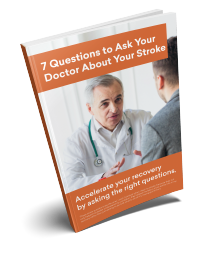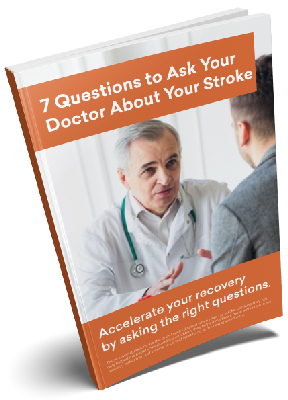Can technology help predict and prevent ischemic stroke?
Luka Fajs is the CEO and founder of Eclipse Diagnostics and holds a Ph.D. in Medical Microbiology. Currently developing a technology that may help predict and prevent Ischemic stroke
Before starting the company he was doing research and clinical laboratory diagnostics of hemorrhagic fevers, biothreats, and other infectious diseases.
Links Mentioned In the Interview:
www.startengine.com/eclipse-diagnostics
To the video: https://youtu.be/G69OtTEDznU
FB page: https://www.facebook.com/eclipsediagnostics/
Highlights:
03:00 Ischemic stroke prevention method.
10:28 Technology under development
13:44 Reaching out to stroke survivors
17:50 The reason behind
23:32 How to administer the test
Transcript:
Bill 0:00
Early on, there’s probably no money in it and it’s not that exciting, but why did you choose stroke? Why did you choose this field of study?
Luka Fajs 0:09
Okay, one of the main reasons is because, okay, I didn’t have a stroke but I did have a very painful experience with stroke through my grandmother. So basically, you know, she was the grandmother, I love her. I spent basically, almost every weekend or every holiday with her.
Luka Fajs 0:29
And, okay, she was older, she was around 80 years old, and she got her first stroke. I still remember when I was basically having fun in the summer on the beach. So from the person that I love, you know, cherish from one day to the other. She basically was nonexistent anymore.
Luka Fajs 0:52
Basically, she lost speech she couldn’t she couldn’t walk. She couldn’t even remember us. She couldn’t remember the names. You can see that she’s staring at you and doesn’t know who you are.
Intro 1:05
This is recovery after stroke with Bill Gasiamis helping you go from where you are to where you’d rather be.
Bill 1:13
Welcome, Luca.
Luka Fajs 1:15
Hi. Hi, Bill.
Bill 1:17
Thanks for agreeing at such short notice to be on the program and also, for making time for me from Singapore. It makes it a lot easier for me to not have to wake up first thing in the morning to connect with you when you’re normally in California. Is that right?
Luka Fajs 1:36
That’s true, the time zones can be a burden. But yeah, now I’m in Singapore. So it’s much easier today.
Bill 1:43
Yeah, it’s fantastic. Finally two hours apart. So may I wanted to touch base with you because when I came across your, a couple of your posts on Instagram, I actually became a little bit intrigued now being a stroke survivor. What I discovered was that the kind of work that you guys are doing in the field of
Luka Fajs 2:07
Stroke prevention.
Bill 2:08
Stroke prevention. And I was wondering, how is that possible? Basically, what I understand about stroke is that most people who experienced a stroke don’t know what a stroke is. They don’t know anyone who’s had a stroke.
Bill 2:24
And when they go through the process of experiencing the symptoms of stroke, they are completely oblivious to those symptoms, and they ignore them. Now, as you would probably guess I’m describing myself because that’s what I did for the first week after the symptoms became apparent.
Bill 2:43
And then after that, I went through the process of getting to the hospital basically at the last minute before I became extremely unwell. So tell me a little bit about your work and what it is that you’re doing to help prevent stroke.
Ischemic stroke prevention method.
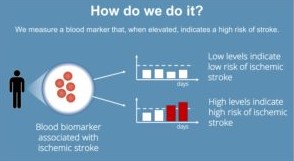
Luka Fajs 3:00
Okay, so basically, it all comes down to like you mentioned in my bio, the core of my work. And the core of our company is a diagnostic platform. So basically a very rapid and very easy to use and affordable testing device that can be utilized for many different diseases, we actually started off testing dengue.
Luka Fajs 3:25
And then we started off doing kidney injury and other diseases. And at a later point, when we were figuring out what is the real need in the world, where can we make the most impact? We found the biomarker, blood biomarker that actually can help prevent stroke.
Luka Fajs 3:44
So what we’re actually doing is we developed or we’re developing a home testing device with which you can monitor your risk of stroke with the endpoint of preventing it. So the way we the way we’re doing it is actually we see the biggest potential, especially in stroke survivors and diabetics.
Luka Fajs 4:05
The main reason is who would be willing to do daily or twice-a-week testing, like a glucometer, like your glucose testing? You know, because you do need a blood break, you need you need to remember to do it, you have to be incentivized to do it. And also further than that, where can we make the biggest impact?
Luka Fajs 4:26
So how it works is basically you take a drop of blood, you put it on a one-time disposable test, and then it gives you a level and that level is basically your risk of stroke. So if you do that on a constant basis on a weekly basis, the moment you see the increase of the blood biomarker that’s connected to stroke, you will get a warning saying look, something is going on, go to a doctor, get a checkup, and get treatment.
Luka Fajs 4:52
Okay, so base so that’s the whole concept of it could be utilized for also people that haven’t had had a stroke already. But it’s just from our point of view, it’s very difficult to, first of all, reach all the people that would need to be reached. And also, as you mentioned, most people don’t ever think they’re going to get a stroke. They don’t know how to stroke what a stroke is. And, yeah, that’s the main point.
Bill 5:20
So I understand that diabetics are at higher risk of stroke, especially people who have been diabetic for quite a long time. So this particular blood biomarker is it’s something new that’s been recently discovered? How is it that you guys came about it what is this blood biomarker?
Luka Fajs 5:39
Okay, so this blood biomarker is currently being used as the point of diagnostics when you have heart failure, okay? So when you have heart failure, or when you have a heart attack, that’s one of the first steps that you get done in an emergency room, right?
Luka Fajs 5:55
And so we were studying this and then we figure out, we’re digging into the literature, and they’re doing some other clinical studies and we actually found out that the same biomarker can be used for monitoring the risk of stroke, the rationale behind it, especially for ischemic stroke.
Luka Fajs 6:13
I have to be very clear about that because we cannot still prevent hemorrhagic stroke, which is very, which is basically very random. Currently, there are no real good biomarkers for hemorrhagic stroke, while as for ischemic stroke, which is caused by a blood clot.
Luka Fajs 6:32
Basically, what we’re detecting is early heart failure and early heart failure can lead to a blood clot and the blood clot basically causes your stroke. So, what we wanted to do is give a very early warning sign for high-risk individuals.
Bill 6:49
Okay.
Luka Fajs 6:50
So basically, if I interrupt, it’s not a diagnostic test, okay? We’re not giving you diagnostics. We’re just giving you a screening. You’re the person that will eventually figure out what’s wrong with you is your doctor, the person that’s going to give you treatment is your doctor. We don’t go there, we just want to bring as many people that are high risk to the doctor that would otherwise stay at home or just get another stroke.
Bill 7:18
I see what you’re saying. So it’s a preventative process that’s based on information and the more information you have, the more likely you are to take steps towards exactly putting the correct procedures in place to intervene so that a stroke and ischemic stroke doesn’t occur.
Luka Fajs 7:35
Exactly, exactly.
Bill 7:37
So tell me a little bit about the process of how this particular biomarker is a predictor for heart failure. To prevent, so prevention of heart failure, or arrhythmia, in a heart, for example. So this particular biomarker could also assist somebody in overcoming not only a serious heart condition but a stroke.
Bill 8:02
So if they don’t have if they don’t have a heart attack, what occurs in an arrhythmia is the blood clot, that gets formed in the heart and then travels up to the brain. So is this something that you would suggest would be useful for somebody that has been diagnosed with arrhythmia to do this particular test to test for both challenges the challenge around the heart and also potential clot forming?
Luka Fajs 8:31
Yeah, okay. So yes and no. So yes, because, we do believe it would be viable or it would be scientifically, scientifically viable. The reason why I’m saying no is because we have to be very careful. You know, we’re a medical device company.
Luka Fajs 8:49
So we have to be very careful of, first of all, what we claim what we want to achieve in the end, and also where we want to make the biggest impact again, From our point of view, let’s say expanding our target user too widely, can be a very big challenge, a very big challenge from you know, from a clinical regulation point of view, FDA point of you.
Luka Fajs 9:19
And even the outreach, to our potential users. You know, it’s, we see that as a first application here because we’re going to be growing eventually. But as our first application medical application, we really want to focus on stroke survivors as our key group.
Luka Fajs 9:40
The main reason is that, first of all, there are many groups of stroke, stroke survivors, who’re very incentivized not to get one another stroke as you might, and most of all, we can make the biggest impact there. You know, the more The high-risk group, the better the prediction of a biomarker.
Luka Fajs 10:03
Because it’s like you mentioned, it’s not very specific. That means that even though it’s very elevated, it doesn’t mean that you’re going to have a stroke, it might mean something else. But it’s a higher percentage of risk if you’re a high-risk group from the start.
Bill 10:20
So this technology, how early on, is it in the development process? Or is this something you have been working on for a little while?
Stroke prevention technology under development
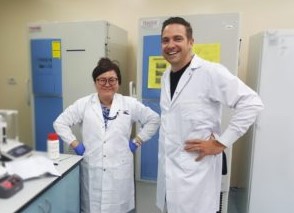
Luka Fajs 10:28
So basically, the technology was innovated, let’s say it here came to fruition. Five years ago in Israel in my co-founder, Professor Robert Marx’s lab at Bangalore University. We then transferred the technology development to Singapore.
Luka Fajs 10:47
So three years ago, we actually started full-on development of the technology. We raised quite a bit of Singapore government funding for it. And as I mentioned, we did it last For sure, but whether it’s for Dankey, whether it’s for kidney failure for fertility, or heart failure. And basically, it’s been a long time in development.
Luka Fajs 11:11
So we are now at a moment where we basically did our job in the laboratory. And we now need to start scaling it up, making it manufacturable and giving it out to users, and doing our clinical studies. So that was the main reason why we started a company, the US Eclipse Diagnostics because we see that it’s going to go fastest to fruition. Over there,
Bill 11:39
How do you see it being rolled out in the sniping role in a private environment? Or do you see yourself combining forces with government organizations, for example, to roll out in hospitals? Is that something that you see happening Howdy, howdy say rolling out.
Luka Fajs 11:59
Okay. Basically, the big What we want to do is keep it more or less private, in a way, we want to reach out to as many stroke survivors as we can. So after we get our FDA approval, we basically want to go direct to the consumer. But of course, we’re also going to be working with our hospital collaborators, because we do have a lot of doctors that are collaborating with us.
Luka Fajs 12:23
And roll it out also with the help of them. But the main reason for that is because, you know, we’re a very small, early company, a startup, basically, we cannot afford to do a big role at the beginning. Yeah. However, in the long term, we do wish to partner with some bigger companies, let’s say established companies in the field, and then use their network of hospitals and doctors to roll it up on a larger scale.
Bill 12:57
It sounds very exciting. I’d love to be able to say it in places especially because one of the main things that I get from stroke survivors, especially people who have experienced ischemic stroke, and the people that I’ve interviewed before you is that there’s always a fear in the back of the mind that it’s going to happen again.
Bill 13:16
And usually, the second one is a lot more dramatic than the first stroke even though the first stroke is obviously dramatic. The second stroke tends to do a lot more damage to a lot more people and I know people have had ischemic strokes and you know, I’ve ended up in wheelchairs and ended up in a very seriously disabled. So it sounds like a really exciting opportunity for people to have some relief in their concerns.
Reaching out to stroke survivors
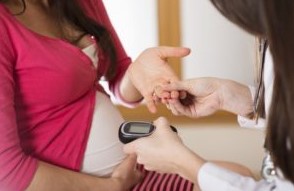
Luka Fajs 13:44
Definitely. And what we’ve seen, you know, as I mentioned, we’re just reaching out at the moment, you know, we’re not selling anything yet. We still have a long runway to develop it. But we’re reaching out, you know, to stroke survivors in groups of stroke survivors.
Luka Fajs 14:00
Because what we want to gain is the inside of what you actually want in a, you know, product. You know, we’re not building. Okay, of course, we’re building it for ourselves, but we want to build it for people who will actually use it. Right. And we’ve been reaching out to the community.
Luka Fajs 14:16
And my first question was, first of all, would you actually want to use it? You know, because I think, you know, this is a great idea. Of course, it’s ours, it’s our baby. It’s our invention, of course, and we think the best of it. But, you know, we ask people to they want to use it, how would they want to use it?
Luka Fajs 14:38
And what struck me really and deeply motivated me to go further, is the response from the people that we got, really, it was, you know, people willing to talk to us for hours and hours, explaining every single detail of how when what happened.
Luka Fajs 14:56
I mean, it was really emotional really to see that kind of openness and generosity of the people that really, you know, you see, they really just want to help and want to get help. And that’s where we are, you know, at this moment, we really want to make something that you know, people will want to use and will know how to use.
Luka Fajs 15:17
Because you know, what our thing is, it’s very similar to a pregnancy test or a glucometer, which in theory is very easy to use. But you never know, you know, a lot of stroke survivors are older people, so they might not be used to it. But I see a very big important factor here, the surrounding community. So friends and family of stroke survivors also help monitor or administer that testing.
Bill 15:46
Yeah, well, I think as far as stroke survivors are concerned, obviously, you want to get back from a stroke very quickly. You want to make sure that you don’t have another stroke, stroke is expensive because not only you know, people out of work, they obviously have many, many years of recovery that they have to do.
Bill 16:06
Sometimes a stroke is a lifelong recovery. So anything we can do to prevent it and keep an eye on markers or risk factors, then it’s positive, you know? Yeah. And stroke survivors obviously go through a lot of emotional highs and lows.
Bill 16:24
And their family and friends and their carers also go through some serious challenges because often, unlike somebody who has a heart condition, perhaps a heart attack. If they survive, which a lot of people do, they tend to have surgery and recover and tend to go back to somewhat of a normal life.
Bill 16:48
Many stroke survivors don’t everything changes after the stroke and it’s very difficult to get back to what was normal beforehand. So that’s why somebody will spend Two hours telling you all the things that they need wanted to do, etc. It’s because we’re highly affected by the result of the brain being damaged.
Bill 17:11
And, we’re concerned about it becoming worse because, you know, I don’t know about you, but many people have told me in the past when I was younger, and I didn’t realize that I was a candidate for stroke, I’ve been told, you know, we’ve said things like, you know, if I ever become brain dead, you know, just kill me or just shoot me or just whatever and, that is the idea that we grow up with.
Bill 17:34
And then as a stroke survivor, you get into that position, and you don’t want to be dependent completely on somebody else. So that’s why everyone’s invited to overcome these challenges. Now, what I want to ask you though, is all right, you’re an entrepreneur.
One of the reasons behind
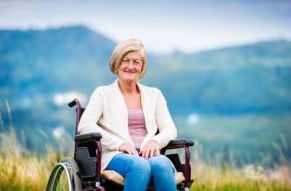
Bill 17:50
And I understand that as an entrepreneur and you know, there’s a few dollars to be made and that’s, that’s perfectly fine. It’s part of the motivating factor. Early on, there’s probably no money in it and it’s not that exciting, but why did you choose? stroke? Why did you choose this field of study?
Luka Fajs 18:09
Okay, one of the main reasons is because, okay, I didn’t have a stroke but I did have a very painful experience with trolling through my grandmother. So basically, you know, she was the grandmother, I love her. I spent basically, almost every weekend or every holiday with her.
Luka Fajs 18:29
And, okay, she was older, she was around 80 years old, and she got her first stroke. I still remember when I was basically having fun in the summer on the beach. So from the person that I love, you know, cherish from one day to the other. She basically was nonexistent anymore.
Luka Fajs 18:53
Basically, she lost speech she couldn’t walk. She couldn’t even remember us. She couldn’t remember the names. You can see that she’s staring at you and doesn’t know who you are. And you know that, as you mentioned, it was very painful for her, of course, and also for the whole family.
Luka Fajs 19:10
But eventually, let’s say it took her like six months to gain some basic function, she could actually recognize us and she couldn’t, she could barely speak but okay, I mean, she got she started to go back on track, but unfortunately then she got another stroke.
Luka Fajs 19:30
And that was it in the end so that was definitely one of the major motivations why we wanted to do stroke. But also from a technological point of view. There are not many applications that medical applications that fit you know, all the necessary needs from a business or entrepreneur point of view.
Luka Fajs 19:56
You know, the special, the special sauce of our technology that we’re able to measure the level of blood biomarkers very easily and cost-effective, right? And in a very short time, that means, like 15 minutes. So when you drill down what the potential application is, you know, people ask me, can you do cancer? And I say, Yes, I can do cancer, of course I can.
Luka Fajs 20:20
But you don’t need to know that you have cancer within 15 minutes from the comfort of your home. Even I would actually rather wait a day to get a diagnosis from a big machine, you know, just perceptually for cancer treatment, you know, because cancer, okay, if you start reading it tomorrow, today, that’ll make a big difference.
Luka Fajs 20:39
While with stroke, you know, it’s a matter of hours or matter of, you know, basically, yeah, that’s, that’s true. And so when you actually go down in medical applications, there are not many that really are urgent, need that quantitative aspect, and in the end, also We have an (inaudible) potential users.
Luka Fajs 21:06
You know, we, as I mentioned, we started off with Dengue fever, then it is a very important disease across the world there are, you know, millions of people that get Dengue every year. And we also had a very good proposition for that. But in the end, nobody cared about Dengue.
Luka Fajs 21:22
You know, the main reason is, you know, who gets dankly people in South America, Southeast Asia. So because it’s not in US, Europe, or Australia, nobody cares about it. So, you know, we try to do the first good deed of, you know, tackling something that’s not as popular but will have a big impact. But, you know, we weren’t able to convince people. Yeah,
Bill 21:51
Tell me a little bit about Dengue. What does it do to the person?
Luka Fajs 21:56
So Dengue, it’s actually Ok, so mosquito-borne virus so when you get it 80% of people have just a very high fever, muscle pain, basically a very, very terrible flu. To put it mildly. However, in 20% of people, you can have very severe Dengue.
Luka Fajs 22:18
And severe Dengue means that you actually can have to go into shock and go into hemorrhagic shock. Get basically symptoms that are similar to Ebola. And today you have very good effective diagnostic tools, a yes or no with you have done your lot.
Luka Fajs 22:34
But it will never tell you if are you going to be that person who has the flu or that person who has an Ebola-like illness. So what we were trying to do is exactly that. We wanted to give a doctor a tool. So when a patient comes, they know what to do with the patient. Because you know often in low-income countries where they have to do it because they don’t have the resources.
Luka Fajs 22:55
They send people hope, and people give and go home you know, they live in remote villages, they get, you know, hemorrhagic Dengue. And they cannot get back to the doctor. You know, we wanted to give the doctor that tool that they know, okay, I keep this patient in hospital and this one can go.
Luka Fajs 23:14
You know, in high-income countries like Singapore, what they do is the exact opposite. They actually hospitalized 80% percent of the patients. What that means is that a lot of people are taking a hospital bed and they don’t need to be there.
How to administer the test
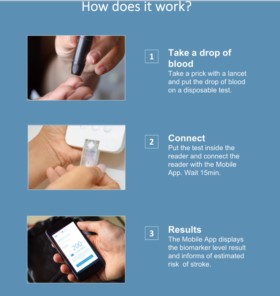
Bill 23:32
And it’s a big expense to the hospital to the population you know, the economy everything. So these tests that you’re developing to predict or to potentially support people so that they can be aware of how their blood is, is showing signs of potential stroke. How do they do the test? Did you say is that a finger prick?
Luka Fajs 23:59
So basically you do a finger prick, and you put it on a disposable one time use test, okay? And that test, you plug in a reader, wait 15 minutes, and then you get a result on your phone. So I can drop your link to the technology and the YouTube video in the description.
Luka Fajs 24:16
So you can actually see how it works in real life. But it basically works the same way, in principle as a glucose meter. We want it to make it as easy to use and of course, costs cost effective, because what you have today in hospitals are very accurate, very good diagnostic tests that they cost.
Luka Fajs 24:38
You know, the reader costs upwards of 1000 USD, the test costs upwards of 70 USD, and that’s just you know, you cannot use that at all. Nobody can. Only a few people can maybe afford it. So you know, our test if you take a look for weekly testing, we aim that you would spend like 60 USD per month.
Luka Fajs 24:59
And you would get a free reader, you would get basically monthly replenishment of tests. And we think that some data is something that a lot of people can afford. And also what we’re going to do, at least we’re going to try very hard is also to get them reimbursed by local insurance.
Luka Fajs 25:19
Because we feel like you mentioned stroke treatment, the initial treatment, rehab, rehabilitation that we have, and all the costs surrounding it are so high that you know, 60 USD, or even a hundred USD per month for insurance companies is a good deal for them, as well.
Bill 25:41
Yeah, absolutely. Because months and months and months and months is a good alternative. It’s not a good alternative for the person going through it or the family. It’s a good alternative for the insurance company, the hospital, and the doctors, the more time these people spend in the hospital, the more resources that they drain, and the lowest hospital beds are available for other people who also need them.
Bill 26:05
I was always very aware of that when I was going through my own rehabilitation. Now I didn’t have an ischemic stroke, I had a hemorrhagic stroke. But while I was in rehabilitation, I was in there for a month. And I got to the point where I was well enough to get out to leave.
Bill 26:22
And I kind of had to start the conversation a bit sooner with my therapists to sort of say to them, Look, I think I can do this rest of the recovery from home because I was of myself one of the lucky ones where, where I was still quite able to be quite independent.
Bill 26:39
And one of the things on my mind was that if I get out of the hospital sooner, the space can be made available for somebody now I know who’s going to be far worse off than me and he’s going to need a lot more rehabilitation. So yeah, I was quite happy to be out of rehab for obvious reasons, obviously, I wanted to be home.
Bill 27:02
But obviously making it possible for other people to get help. Because we have the same problem in Australia every country has a limit of beds and the limit of resources. It doesn’t ever end. I know that. I know that the blood glucose test has changed the lives of diabetes patients because they can manage their diabetes at home that it needs to be constantly at a doctor’s.
Bill 27:33
They don’t need to be constantly traveling to appointments, etc. They just measure themselves and then they take the medication as required. So I see that this, you know, could do that as well. It could create a situation where time is given back to the person recovering from stroke because the last thing that I wanted to do was be at many, many, many appointments.
Bill 27:57
And at one point, I was going to Three appointments awake for a number of months. And that three appointments awake, even if I was able to get back to work still interferes with that ability to get to work still interferes with, you know, my ability to, you know, get my life back so I can see how this will be beneficial.
Bill 28:18
And yeah, it’s why I became extremely interested when I came across, your Instagram page. I’m not sure if there’s anything else I should ask, because this is so new to me and I didn’t understand the topic. So is there anything else that you’d love to tell us about that? I haven’t asked.
Luka Fajs 28:40
Well, I mean, in terms of stroke, you know, it’s what I love about the technology and you know, what we’re trying to do is especially if, you know, if you’re a stroke survivor, I don’t need to tell you that. This is something that’s very needed.
Luka Fajs 28:57
And as you mentioned, we really want to make this as the diabetes test glucose test, for stroke, right? Because we just want to give people another tool, another option, you know, an early warning sign. Because today, the only thing that you actually have is zero, you probably measure your blood pressure.
Luka 29:18
And that’s all the preventative that you can get, unfortunately, but the other thing that you know, some people ask me, so what then? So for example, you get a high, high number, and what happens then right, so is there any treatment associated with it? So basically, what we see how it would work is that if you have a very high level, we would basically inform you to go to a doctor.
Luka Fajs 29:47
And then the doctor once they complete their test, they actually have a few options either they give you a very strong club buster, clod buster, or they can actually if they identify where the thought is that can actually put it out today with these new methods. So that’s something that we see how you can actually benefit.
Luka Fajs 30:12
And for the future what we actually want to do is also move on not only for stroke it actually because we know we have a platform, we basically the easiest way you can imagine it is that we have a printer and then we just can add new cartridges into it. So what we’re doing is stroke is one of them heart failures and other them. Then, of course, kidney failure. And even you know, for veterinary military us. This is something we have in our minds for the future.
Bill 30:44
Yeah, I see what he’s saying. So, develop the product of the prototype and do the testing and the stroke. You know, supporting the stroke, people or in that community. Get it, get it working. Get some good data behind you And then see how you can evolve it and implement it in other areas.
Bill 31:04
Once that’s been proven, you know, to the next level, where there’s really good statistics, I like the idea of that I like that stroke is first, I, I wish that you could help everybody or all at the same time, but I know that you can’t. But what I like about it is that it will give peace of mind to people who have that thought in the back of their mind is okay, I’ve had one.
Bill 31:30
What, you know, what makes it what makes me you know, comfortable that I’m not going to have another one often people really struggle with that. And, you know, when you experience a stroke, you don’t have to be in the 80s. You know, a lot of people are extremely young. And I was 37. And a lot of the people that I know were in their 30s when they had a stroke.
Bill 31:50
So I don’t know anyone who’s older, who’s had a stroke registered know really young people, and a lot of these people had another 30 or 40 years of productivity. You know, thanks to give back. And a lot of those people won’t have the opportunity to do that. So anything that helps people, you know, be healthier for longer, I think is a great thing. Where can people find more information about this? Is there a specific website they should go to? Or have a look, we’ll put all the links them in the comments, but where can people find
Luka Fajs 32:28
so basically the most information people can find is on our start engine, slash Eclipse diagnostic site. So what we’re actually doing in the US, we are crowdfunding our project as well. To enable the research further, and I’ll put the link I’ll send you the link. And I’ll also send you the link to our YouTube channel and our Facebook where people can find the most up-to-date information about Our progress what we do and if they have any questions, they can just, you know, send us a message and we’ll be glad to answer any of the questions they might have.
Bill 33:10
Yeah, excellent. This is called recovery after a stroke. Unfortunately, the name is more fitting to what it is that’s happening. We are experiencing a stroke and we’re recovering after a stroke. I wish it was called Stroke Prevention podcast. But no one’s interested in stroke prevention. Unfortunately, we all only seem to pay attention to what has happened to us when it’s happened to us.
Bill 33:35
And and then when we what we start paying attention often in the past, there’s never been any tools to help us prevent stroke. So this is amazing that you guys are working on this amazing that you even came up with it. And I really thank you for your time and I wish you all the best in your endeavors. And I hope that you guys get it over the line soon and make a massive difference. I’ll be following with interest.
Luka Fajs 33:59
Thank you very And thank you for inviting me to your podcast. I’m glad to see that you’re one of the lucky ones. Like you mentioned really good luck with everything and I hope that in the future we’ll have tools to prevent stroke.
Bill 34:15
Yeah, mate so do I. Why thank you so much. I really appreciate it. Enjoy the rest of your time over there in Singapore.
Intro 34:21
Discover how to support your recovery after a stroke. Go to recoveryafterstroke.com



